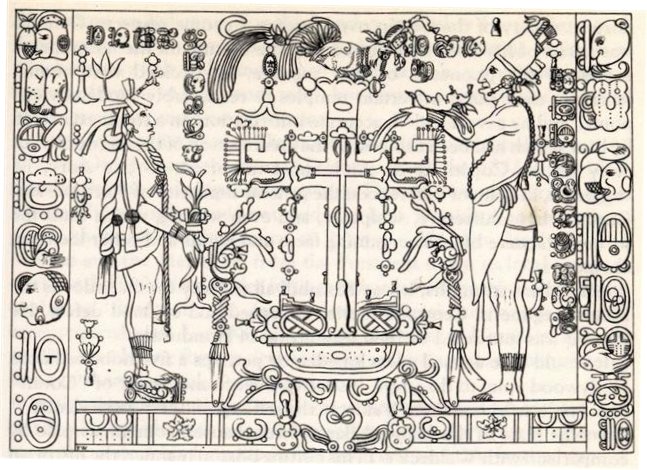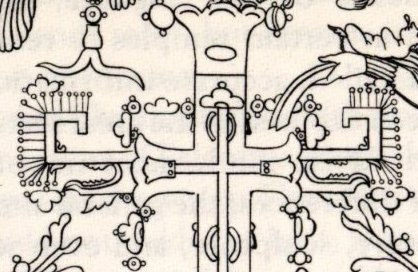5. The 'tree signs' (rakau according to Metoro) are possibly far away related to our own Christmas Trees, with beautiful bulbs at the tips of their branches:
However, the 'bulbs' in the glyphs should not be thought of as separate entities, they are probably to be understood as integrated 'branch + bulb' signs, so much we can read from the following complex Maya illustration of 'the Tree'. I have copied it from Michael D. Coe's Breaking the Maya Code, who in turn copied it from an old engraving based on a drawing of the Tablet of the Cross at Palenque:
The cross in the center obviously represents the 'World Tree' and beyond the ends of its horizontal beam is a kind of prolongations decorated with multiple signs of 'branch + bulb'. At top left there are 8 such, then moving downwards there are 10, which together makes 18. After that only 4 remain, and these are upside down. At top right there are 7, and then moving downwards we find another 10, and ultimately 3 upside down ones. However, one of these 22 + 20 = 42 signs is special, viz. the leftmost of those 7 at top right. Its 'bulb' is attatched to a double 'branch'. It is not drawn like a needle but like a stem:
On the other hand, at left, there is another special case, viz. the next but last sign, the 3rd one of those upside down, where the creator has drawn the object below so as to suggest a pair of bulbs at the end of the needle. Thus the missing bulb at the beginning of the righthand series can be regarded as compensated by an extra bulb at bottom left. There are 42 'bulbs' but only 40 'needles' (plus one 'stem'). The top righthand special case could refer to the great star Sun, while all the rest could represent ordinary stars, for instance such which rise together with Sun at different times during the year. The right side is the side of Sun and the 10 vertically arranged 'needles' increase in length downwards. On the left side there are also 10 vertically arranged such signs, but with longer needles and not they are not increasing in length downwards. Probably also these 10 represent positions of Sun, but presumably in autumn instead of in spring. 10 + 10 = 20. The horizontal direction then remains for Moon, who from left to right at the top has 8 + 6 = 14 'bulbs'. At bottom their numbers are 4 (or 5) + 3 = 7 (8), which added to 14 becomes 21 (22). The vertical dimension of Sun cannot refer to his daily motion, instead it must refer to his seasonal movement, coming closer and closer and then receding again. |



